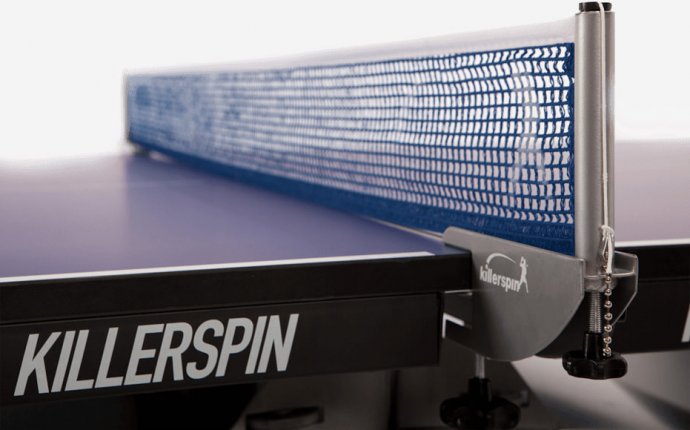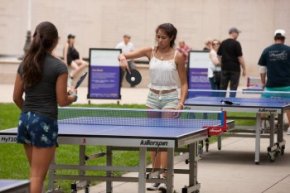
Ping pong rules net
 You enjoy an occasional game of table tennis, but don’t have enough time to explore the vast world of ping pong rules? Or just don’t feel like going through five pages of things just to get an answer to one question?
You enjoy an occasional game of table tennis, but don’t have enough time to explore the vast world of ping pong rules? Or just don’t feel like going through five pages of things just to get an answer to one question?
We feel your pain.
- How long is a game?
A game in table tennis is played until one of the players scores 11 points or if there is a 2 point difference after the score was tied (10:10).
A game used to be played until 21, but that rule was changed by the ITTF in 2001.
- How long is a match?
A match can be a best of any odd number of games: 3, 5 or 7, but most people play 5 games.
- How many serves does each player get?
Each player gets 2 serves, and it alternates until one of the players scores 11 points, unless there is a deuce (10:10). In that case, each player gets only one serve and it alternates until one of the players gets a two point lead.
- Do I need to serve diagonally (like in a regular tennis game)?
No. If we’re talking about singles, the only thing you need to do is hit the ball so that it passes over the net and hits the opponent’s half of the table.
In doubles, however, the ball needs to hit the right field of the opponent’s half.
- Where do I need to stand during a serve?
If you’re the person serving, you need to stand behind the end line of the table, and the ball needs to be visible, and above the surface of the table. The receiver can stand wherever he deems ok.
In practice, this is not done very often since it can put the server out of position for the rest of the rally.
- What happens if the balls hits the net, or goes around the net?
 During a serve, if the ball hits the net but still bounces on the opponent’s side of the table, the point is a let (which means it needs to be replayed). If the ball hits the net and doesn’t make it to the other half of the table, the receiver is automatically awarded a point.
During a serve, if the ball hits the net but still bounces on the opponent’s side of the table, the point is a let (which means it needs to be replayed). If the ball hits the net and doesn’t make it to the other half of the table, the receiver is automatically awarded a point.
During a rally, if the ball hits the net but still bounces on the opponent’s side of the table, the rally continues, but if the ball hits the net and doesn’t make it to the other half of the table, the receiver is automatically awarded a point.
So basically, as long as the ball does not go under the net, or between the net post and the net for those nets that do not extend to the net post, it is considered to have passed over or around the net assembly if you hit the ball and it goes on the opponent's playing surface.
So, even though the ball doesn't travel over or around the net when you hit the ball, the rules say it doesn't matter.
This shot is only ok, as long as the ball does not end up hitting the side of the table top (white line is acceptable, side is not).
- Can I serve a game/match point (or does my opponent need to serve if it’s my game/match point)?
This is one of the most frequently asked question, and the answer is: Absolutely!
- What happens if you hit the ball (whether it’s during a serve or a rally), and once the ball hits the opponent’s side of the table, it bounces back to yours (due to spin)?
In this situation, the point would be awarded to you. The opponent in this case has to hit the ball before it passes by net assembly and is back in your court.
 If a player reaches across the net assembly and makes a contact with ball, he loses the point immediately. And if the player hits the ball in his own court, by definition it's an invalid return so he loses point again.
If a player reaches across the net assembly and makes a contact with ball, he loses the point immediately. And if the player hits the ball in his own court, by definition it's an invalid return so he loses point again.
TIP: Either way, try to avoid doing this on purpose. This is a tricky shot, and it’s very hard to control it. In most cases, the ball will end up being too high, or it will hit the net.
- If the ball touches the opponent but not the opponent’s side, whose point is it??
Let’s keep things simple and say that you should never, in any situation hit the ball if it hadn’t touched your side of the table first. That is known as valley or “obstruction”, and it’s an illegal shot in table tennis.
To make it easier to remember, let’s put it like this: you are not allowed to hit the ball while it’s on its way to the table. If you do this, and you obstruct the path of the ball (whether it’s with your paddle or any part of your body), your opponent will be awarded with a point.
If you hit the balls after it had already passed the end line of the table, you would get a point, since your opponent failed to make the ball hit your side of the table first. Either way, you should avoid doing this altogether, that way you won’t hit the ball unintentionally and obstruct its path.
- What happens if you touch the table?
If you touch the table surface with your free hand (the one that’s not holding a paddle) during a rally, your opponent will be awarded with a point automatically. This also applies if you move the table with anything you’re wearing or carrying.
- What happens when a player serves or scores illegally, but there is no qualified umpire to call it?
This is a very common problem. Sometimes the rules are just not specific enough and can be open to interpretation, but other times you just need an unbiased person to decide whether a shot is legal or not.
When this is not the case, and there is no qualified umpire present, you’ll have to rely on the so-called “honor system”. The “honor system” means that the players need to come to an agreement amongst themselves.
The best way to that is to set some ground rules before the game, and discuss some of the situations you feel are probably going to happen.
We know that table tennis rules can be a little daunting at times, and that we just scratched the surface here. That’s why we made it our mission to help our fellow ping-pong lovers understand the game a little better by publishing weekly blog posts that will help even the least experienced players.
Stay tuned, and in the meantime if you’re impatient, feel free to contact our expert Concierge Service, they’ll be happy to answer all your questions- even the ones you think are stupid!









